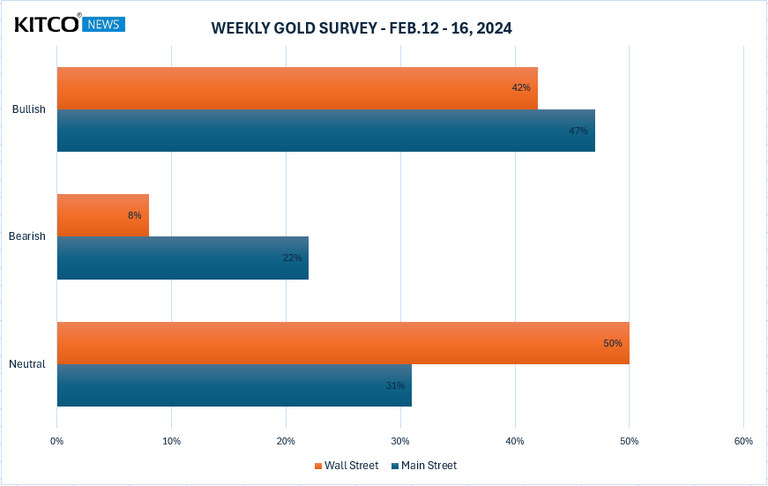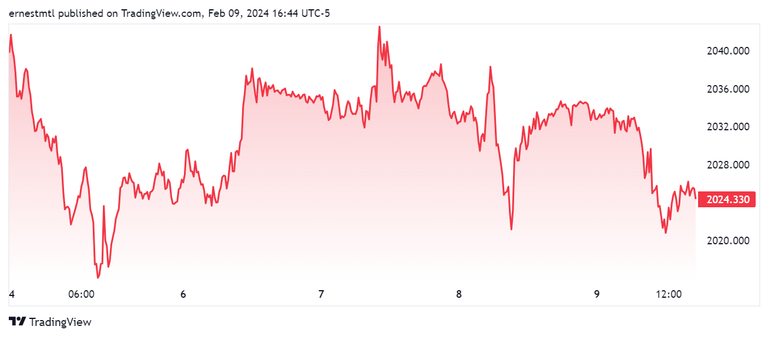(Kitco News) – The most dramatic moves in the gold market were made early this week, as spot prices kicked off Sunday night trading above $2,041 per ounce before falling to their weekly low of $2,016 by 9 am EST Monday morning.
Afterwards, gold prices largely traded within that range, though the spot market did set its weekly high of $2,042.53 on Wednesday morning, and tested support near the $2,021 level on both Thursday and Friday.
The latest Kitco News Weekly Gold Survey showed Wall Street and Main Street back in the same neighborhood as far as price expectations, with both seeing very little chance of a significant selloff in the coming days as the market arrived at a consensus forecast of ‘steady with a chance for gains’ next week.
Adrian Day, President of Adrian Day Asset Management, sees gold’s continued sideways price action in a positive light. “Gold has already pulled back after Federal Reserve chairman Jerome Powell dashed expectations of a near-term rate cut,” he said. “Now gold can find its base again and start to move back up. The start of the bull market has been postponed but not cancelled.”
James Stanley, senior market strategist at Forex.com, is back in the bull’s camp after doubting gold’s near-term potential last week.
“Bulls have held 2k well so far and even when the U.S. Dollar put in its largest two-day rally in a year, gold held higher-low support,” he said. “So bullish structure remains and there’s been defense of that structure so far.”
That said, Stanley believes the next price trend will be driven by the CPI report. “If we see Core CPI print over 4% annualized that could cause some pandemonium to risk trends, and I think that could negatively impact gold,” he said. “But I’m expecting CPI to come in soft and I think that could give bulls a shot in the arm.”
Bob Haberkorn, Senior Commodities Broker at RJO Futures, said that Friday’s gold price weakness was markets reacting to Chinese data while betting on next week’s U.S. data.
“I think it’s anticipation into next week’s numbers here,” he said. “Maybe some traders getting out ahead of that, but also the big thing was the Chinese inflation data yesterday showed a cooling over there. That is what started the trigger on this thing.”
Haberkorn also pointed to rising equities taking the wind out of gold’s sails. “You have a pretty hot U.S. stock market right now, and it’s been risk-on back into the market,” he said. “We’re trading on the S&P above 5000, and NASDAQ’s making highs as we speak, so gold loses a little bit of its luster here when the equities are as strong as they are.”
He said prices are stuck in a range between $2,000 and $2,075 right now. “We need a move above $2,075 from a technical standpoint to signal anything new on a breakout, which could come next week with the data that’s coming out,” he said. “But this week with a strong U.S. stock market, weaker-than-expected Chinese inflation data, it’s just an environment where it’s hard for gold to manage any rally.”
“It seems to be a cautious trade right now for this week,” he said. “And next week, I think we’re going to be just data-dependent on where this thing goes in the market. As of right now, I’ve got to say I’m neutral on it. But it depends on how the data comes out.”
Haberkorn sees risks to the downside next week as well. “If we break through $2,000 here, gold realistically could have a move all the way back to $1,950, and maybe even further than that, because it would wash a lot of the longs out, and you would see some bears come back in and reestablish for a push lower.”
He emphasized that gold’s near-term direction would really be contingent on the inflation data. “If it comes out better than expected here, cooling, it will probably rally because it’ll signal to the Fed that they’re more in a position to cut rates,” Haberkorn said. “If it comes out higher than expected, then gold probably will take out $2,000 because the rate cuts might be later than sooner. It’s upside down, but given the environment, right?”
Haberkorn agreed that the Biden administration’s retaliatory strikes against Iran-allied groups were already priced in before they happened, and markets are now waiting for the next geopolitical trigger.
“Really no new geopolitical news, I know the Red Sea situation they’re saying is deteriorating, the Israel situation is still ongoing, as well as Ukraine. There’s still been continuing attacks by Iranian proxies,” he said. “But I think what would be a catalyst for gold to go higher is if there was a direct strike in Iran, or there is something with the Iranian Revolutionary Guard actually being front and center on an attack in Iraq.”
“If Iran got more directly into the fray, or we got more into the fray with Iran, or in the Red Sea with the Houthis, if there’s a significant development there, that would be a catalyst for gold to trade higher.”
This week, 12 analysts participated in the Kitco News Gold Survey, and Wall Street appears to have largely discounted all downside risks to gold prices in the near term. Four experts, or 42%, expected to see higher gold prices next week, while only one analyst, representing a meager 8%, predicted a price drop. Six experts, fully half of those surveyed, expected gold prices to trade sideways during the coming week.
Meanwhile, 165 votes were cast in Kitco’s online polls, with a near majority of Main Street maintaining a bullish attitude. 77 retail investors, representing 47%, looked for gold to rise next week. Another 37, or 22%, predicted it would be lower, while 51 respondents, or 31%, were neutral on the near-term prospects for the precious metal.

U.S. inflation data will once again take center stage next week, with the release of January’s CPI report on Tuesday morning, the final PPI print for December on Wednesday, and initial January PPI on Friday.
Markets will also be paying attention to weekly jobless claims and U.S. retail sales for January, as well as the Philly and New York Fed’s manufacturing indices, all set for release on Thursday morning, followed by January housing starts and building permits and February initial UMichigan consumer sentiment on Friday. There will also be a smattering of central bank speakers throughout the week.
“I look for gold to strengthen in the coming days, helped by soft US inflation and retail sales,” said Marc Chandler, Managing Director at Bannockburn Global Forex. “I expect those data points to put a cap on US yields and the dollar. Still, it looks comfortable in a $2000-$2050 range.”
Darin Newsom, Senior Market Analyst at Barchart.com, doesn’t expect any big surprises or price movements from the U.S. data next week. Instead, he believes gold will get its direction from geopolitical developments at home and abroad.
“Number one, they’re all just numbers, and they’re going to be heavily debated,” Newsom said. “One side of the aisle is going to say they’re all false, the other side is going to say they’re perfect and they’re showing that we’re making good progress, the U.S. economy is percolating along, and all these other things. So it’s going to be basically just same-old.”
“Gold has found itself locked in a sideways trend now for the last week and a half, and it will likely break out next week,” he said. “There’s no way of telling, big-picture certainly looks like U.S. inflation probably is a bit under control, so there’s no huge worries there, not really expecting anything outlandish in any of the numbers.”
Newsom said the real market-moving news could be what happens over this weekend. “We know a lot of the global events are also tied to U.S. politics, and with some of the latest developments, what’s the next move?” he said. “With Russia, Ukraine, Middle East, Black Sea, what’s going to be next to try to disrupt not only the global political system, but global economics? And will that break gold out of its sideways range?”
“We’ll get China going into a holiday, so next week could be pretty quiet again,” he added. “I see the market in this sideways range. I don’t see anything as far as data or government numbers coming out that’s going to change that. It’s going to take some sort of chaos event that changes our course.”
Newsom said these events could include developments related to former President Donald Trump’s Supreme Court case to remain on the ballot, as well as the ongoing conflicts overseas.
“I think it’s all tied together,” he said. “Obviously, Russia and China are watching that very closely. There is a good reason why Trump loaded up the Supreme Court the way he did, so anyone thinking it’s not going to come down in his favor to stay on the ballot is sadly mistaken. This thing’s going to be dragged out to its awful end next November, there’s no way around it.”
“I do think the geopolitics are going to continue to come into play, and they’re going to intensify as we get closer to November,” Newsom said. “We’re going to have more disruption, both economically and politically.”
What Newsom finds interesting is the way that global markets have adjusted. “If we look at food and fuel prices, we haven’t seen the big [crisis],” he said. “The world was going to run out of wheat. The wheat market has been under pressure the last number of years. Similarly, the world’s going to run out of energy, Russia’s going to put all this pressure on the energy market. OPEC+ got in the mix by continuing to cut production. But the U. S. became the largest oil producer in the world and offset those production cuts.”
“Right now all the money is pouring into U.S. stocks, and things like gold and crude oil and some of the other key commodity markets are seeing money actually coming out of them,” he said. “But the wild card continues to be the chaos events, the geopolitical events.”
Mark Leibovit, publisher of the VR Metals/Resource Letter, said he still sees downside potential for gold prices in the near term, but he’s firmly bullish beyond that. “Risk remains under 2000 to the 1950-1980 range,” he said. “Still overall bullish with intermediate targets as high as 2700 and near-term target around 2300.”
And Kitco Senior Analyst Jim Wyckoff expects gold prices to continue trading within their recent range next week. “Sideways and choppy as precious metals traders await the next new, major, fundamental market development,” he said.
After bouncing just below $2,021 per ounce at 11:30 am EST on Friday morning, spot gold has trended higher throughout the afternoon, last trading at $2,024.33 at the time of writing, but still remains down 0.75% on the week and 0.48% on the day.
Disclaimer: The views expressed in this article are those of the author and may not reflect those of Kitco Metals Inc. The author has made every effort to ensure accuracy of information provided; however, neither Kitco Metals Inc. nor the author can guarantee such accuracy. This article is strictly for informational purposes only. It is not a solicitation to make any exchange in commodities, securities or other financial instruments. Kitco Metals Inc. and the author of this article do not accept culpability for losses and/ or damages arising from the use of this publication.
Credit: Source link
